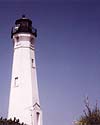 |
 |
| Skillagallee Island Light Station | Seeing The Light |
|
|
|
|
Historical
Information Being very low in elevation, the island is barely visible except from close by, and to exacerbate the problem, the size of its exposed surface fluctuates dramatically with the level of the surrounding water. The island was considered a navigational hazard during the earliest days when the French Voyageurs took the time to name the place "Ile aux Galets," which translates as "Island of Pebbles." A is so often the case, the English speaking mariners and settlers found the French name difficult to pronounce, and "Ile aux Galets" soon unofficially mutated into "Skillagalee." The anglicized version took hold, and by the mid 1800's references to the original French name all but disappeared. While Skillagalee laid claim to many wrecks over the years, the grounding of the A.D. PATCHIN was seminal in the call for the construction of an aid to navigation on the island. The PATCHIN was a 226 foot wood-hulled sidewheel steamer built in Trenton Michigan in 1846. Laden with general merchandise, she was making her way into Grays Reef Passage on September 27, 1850, when the currents pulled her out of line and onto shore at Skillagalee. While her crew managed to escape to safety and the initial damage to her hull was minimal, the weather turned evil and thwarted a number of attempts to pull her free. By late November she had been pounded to pieces, becoming yet another of Lake Michigan's many victims. To answer the need for a navigational aid to warn mariners of the shoal's existence, Congress appropriated the necessary funds to construct a light on Skillagalee Island in 1851. As a result of the exposed location and fluctuating water tables, the tower was in constant need of repair, a cycle that would be repeated throughout the station's history. By 1868, the tower's condition had deteriorated to the point that it required a complete rebuild. Also with this rebuild, the Lighthouse Board upgraded the station's illuminating apparatus from the old Lewis lamp array specified by the Fifth Auditor's administration to a superior Third Order Fresnel lens. The station's complement of structures was completed with the construction of story-and-a-half keepers dwelling and a fog signal building. The fog signal plant consisted of a steam-powered steam siren.
In 1890, the decision was made to upgrade the station's existing steam siren to 10-inch steam whistles. On October 4th of that year, the Lighthouse steam barge RUBY delivered a work party and the necessary equipment for the upgrade. With the upgrade completed on November 14, the RUBY returned to Skillagalee to pick up the work party, and to transfer the old sirens to Beaver Island for installation at that station. Life was busy for the keepers at Skillagalee that following year, since in addition to tending the light and maintaining the equipment, they operated the station's new steam whistles for a total of 268 hours, and stoked 26 tons of coal into their boilers. As witness to the ever fluctuating cycle of Great Lakes water levels which plagued Skillagalee over the years, the landing crib, boathouse and boatways were all moved fifteen feet seaward during the 1894 navigation season. In 1969, a Coast Guard crew demolished the keepers dwelling, fog signal building, oil storage shed and boathouse, leaving the tower standing alone in the middle of the island. The Fourth Order Fresnel lens was removed from the lantern, and replaced with a 300mm acrylic plastic lens, powered by 12-volt DC batteries, receiving their charge from a photovoltaic panel mounted on the gallery handrail. Keepers of this Light Seeing this Light
Reference Sources |
This page last modified 12/01/2007